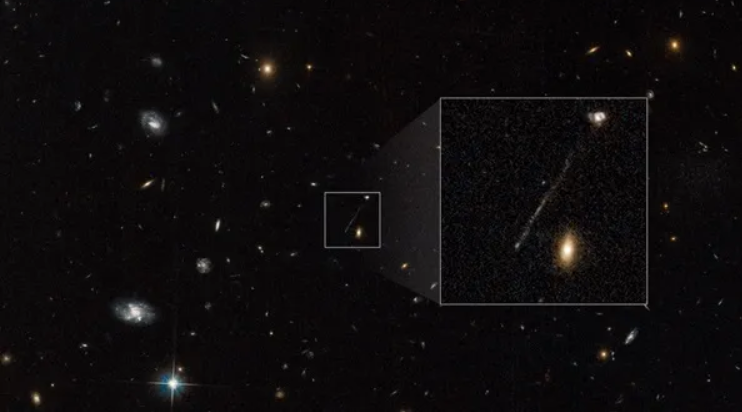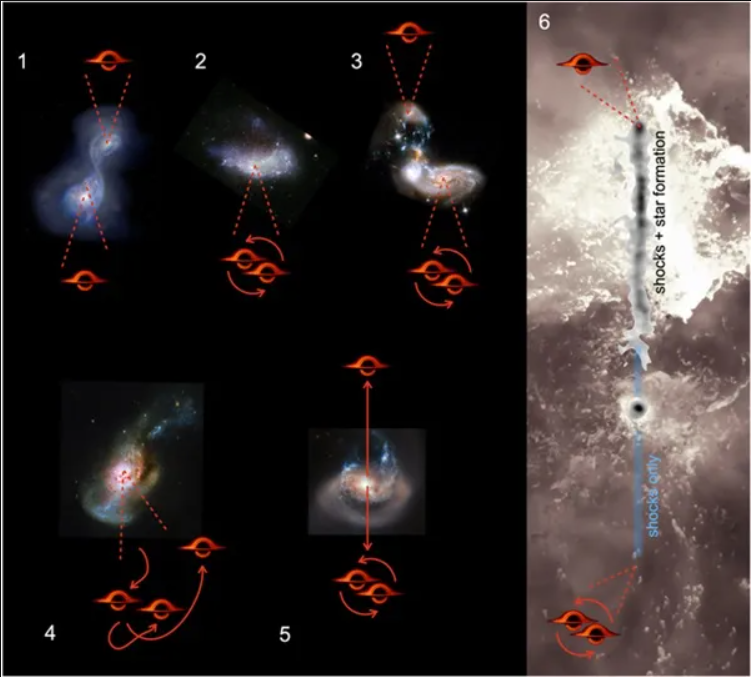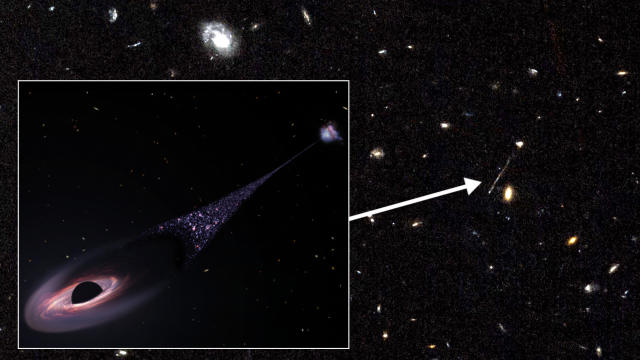Hubble Spots Escaping Black Hole Leaving Behind a Trail of Recently Created Stars.
A groundbreaking discovery has been made by astronomers, revealing the existence of an enormous black hole that is approximately 20 million times the mass of the Sun. This colossal supermassive black hole is rapidly moving away from the core of a distant galaxy, leaving behind a remarkable trail of newly formed stars that extends over an astonishing distance of about 200,000 light-years.
Pieter van Dokkum from Yale University, who was the first to identify this trail of stars, has observed that there is a wake behind the black hole where the gas cools down and facilitates the formation of stars. This phenomenon can be compared to the wake left by a ship, providing a glimpse into the aftermath of the black hole’s journey.
Despite its slender appearance, the stellar wake created by the black hole is filled with hot blue stars, making it nearly half as bright as the galaxy it originated from. Researchers speculate that this black hole may have been ejected during a complex interplay involving three supermassive black holes during a series of galaxy mergers. If confirmed, this would serve as the first observational evidence of supermassive black holes being expelled from their host galaxies.
The detailed findings of this runaway black hole and its stellar wake have been published in The Astrophysical Journal Letters.
Although black holes cannot be directly seen, they often leave behind visible traces of their existence. One such example is the presence of dense disks of swirling, intensely heated gas and dust known as accretion disks, which emit significant amounts of light, thus revealing the presence of the black hole.

In this particular instance, it was not a disk of matter accumulating around a central object, but rather an extraordinary linear mark connecting it to a neighboring galaxy that captured van Dokkum’s attention. Initially noticed in an image taken by the Hubble Space Telescope, the mark was later confirmed to be linked to the galaxy through subsequent observations carried out with the Keck Observatory in Hawaii.
Van Dokkum described the discovery as fortuitous, as he stumbled upon it while examining the Hubble image for an unrelated purpose. Initially disregarding it as a potential artifact in the image, further examination revealed its persistence even after eliminating interference from cosmic rays, indicating its authentic nature.
The researchers contemplated the possibility of the mark being an astrophysical jet originating from the central black hole of the nearby galaxy, a common occurrence in such systems. However, the intensity of the mark increases as it moves away from the core of the galaxy, and it does not dissipate at its end. This led the researchers to conclude that it is, indeed, a trail of newly formed stars.
Furthermore, at the farthest end of the mark, where the suspected black hole is believed to reside, evidence of a shock wave preceding the black hole was also observed. This shock wave occurs due to the high-velocity impact of the black hole as it moves through the surrounding gas at supersonic speeds.

The astronomers have put forward a theory that suggests the runaway black hole was possibly ejected from its original galaxy due to two consecutive galaxy mergers in the recent past. The first merger, which took place around 50 million years ago, caused the supermassive black holes of the two galaxies to start orbiting each other.
Following this, a subsequent merger involving a third galaxy led to a chaotic interaction among the three supermassive black holes, resulting in the expulsion of the solitary black hole from the system. The researchers also anticipate that when the isolated black hole was ejected, the remaining pair of binary black holes would have been propelled in the opposite direction.
In order to verify this hypothesis, the team plans to carry out additional observations using the James Webb Space Telescope and the Chandra X-ray Observatory.
Do not forget to share your opinion with us to provide you with the best posts !




0 Comments